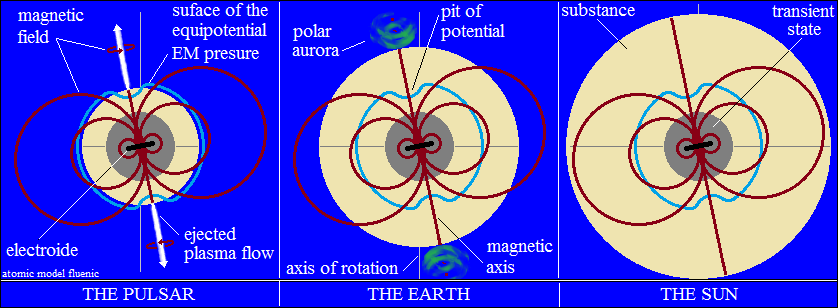Astronomical
phenomenas - pulsars
Modern telescopes capture from the universe, images of small stars,
characterized by high speed of rotation and strong magnetic field,
with beams of radiant substance coming out of magnetic poles
Structure of pulsars
Vector interpretation.
The image of the pulsars can be explained by the interactions of the component
phenomena of the star.
The small size, very high rotational speed and also gravity,
are the result of a large supply of substance from the vicinity.
The star is in the accumulation, growth stage.
Strong magnetism demonstrates the existence of a strong electroide.
The electroide and its magnetism, the electromagnet of the star,
have the sense and force of the vectors strictly with the same orientation,
as a singular particle.
From this results the huge density and the centripetal and angular accelerations
without friction, with the speed of light.
The balance between these accelerations establishes the motion of bodies
in orbits
(planetary and galactic systems).
The coupling between the electromagnet and the mass of the star is inductive
(cardanic).
Thus, the weight of the pulsar has the rotation motion dependent inductively
on the angular acceleration of the electroide,
and the inertia of the moving mass ensures the stability of the spatial
coordinates.
The electroide (electromagnet) is dependent only on the pressure generated
by its accelerations, centripetal and angular.
The electromagnet is the source of these accelerations, independent of
the mass of the star.
The characteristic phenomenon of pulsars
The pulsar is "the phoenix bird born from the ashes of a supernova".
Due to the shape of the electroide, the equipotential surface
of the electromagnetic pressure presents a pit in the magnetic poles area.
By the minimum limit of the pits, high pressure ejects plasma.
Plasma ejected with high speed and polarized, it forms a true "infinite"
electromagnetic current.
The current, the polarities of the plasma oriented in the same direction,
compressed
by its own magnetic field propagates coherently.
They are electromagnetic (vector) interactions, active in the "hydrodynamic
paradox" and in tornadoes.
The phenomenon is not characteristic only to pulsars, but to all stars,
but they have magnetic poles covered with substance.
And the earth "ejects plasma" in the area of the poles - the
polar auroras.

